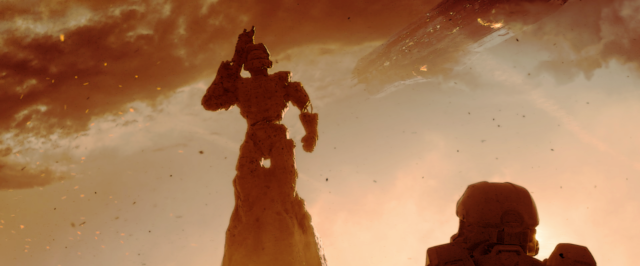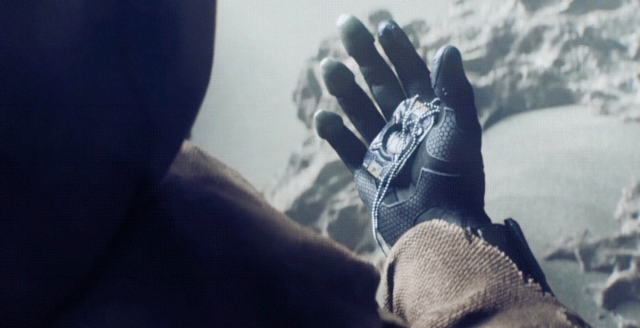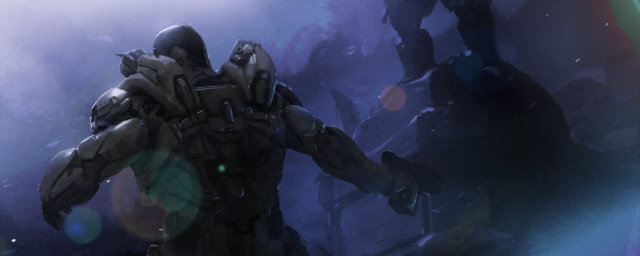
The controversy surrounding Halo 5’s story seemed to draw in fans’ collective attention, leaving much of the marketing’s genuine passion woefully under-examined and overshadowed. Whether unfounded or not, it is clear that threaded and woven below the surface of the game’s advertisements is a truly intriguing collection of narratives that are oft overlooked. In the midst of hunting the truth and discovering the official story, we never stopped to examine what made us chase both so fervently.
The Master Chief is, on the surface level, a fairly simple character. He is defined by three things: his suit, his weapon, and his A.I. companion, Cortana. Halo’s novel extensions and more recent game titles have begun to explore the deeper meaning of his morals and humanity, or lack thereof, as we’re now forced to closely examine John under the thick veneer of sage metal that entombs him. John is subjected to the flattening demolition of the foundations of his character, and thus, the holy trinity is torn from his grasp. Without his sword, his shield, and his voice of reason, he’s abandoned, and it’s in this state that he can begin to regain his obscured humanity. 2013’s “Halo on Xbox One” trailer, a surprisingly poignant endeavor, manages to successfully depict John’s state of suffering and how it has affected the world around him, delivering thoughtful storytelling in a matter of minutes.
The teaser’s careful examination of John not only strips him of his identity, but it experiments with the viewer’s expectations of the Spartan. The attachment to John is not entirely one of character and narrative, but of perspective, as we’ve become accustomed to view the world of Halo the same way he does. The audience latches unto the trinity mentioned earlier and is disquieted when these attributes dissolve. For the duration of the trailer, John is not shown suited in his usual Mark VI gear, instead shrouded in dusty cloth. He does not carry a firearm, uncharacteristically defenseless. Additionally, the only representation of Cortana is a fractured physical manifestation of her connection to the Chief. The rippling cracks in John’s visor are purposefully placed on the right, covering the area on the heads-up display that typically represented John’s weapons and subconsciously informing the watcher that this part of his identity is permanently fragmented.

An element that Halo’s marketing, lore, and mainline gameplay has continually succeeded at is humanizing its Spartan characters without the need to see their facial expressions. While not limited to just this series, Halo is certainly forced to rely on other methods of emotional communication, with its main protagonist being exclusively hidden behind his helmet. The advertisement “All Hail” is arguably one of the best depictions of these methods, resonating passion as emotional impact saturates the mind of the viewer. Jameson Locke’s somewhat uneasy, deranged vocals work in tandem with his striking walk, each step seemingly choreographed to display emotional shifts. His pace quickens when his tone becomes more intimidating, threatening, much like a predator closing in on its prey. But he is slow and goading when he berates John, the swinging motion of his helmet spearheading his strange mannerisms. It is an arguably more emotional display of Locke’s intentions than we’ve seen since, commendably immersive and investing in a teasing manner that sadly isn’t built upon.
To talk about “All Hail” without mentioning its follow-up, “The Cost”, would be doing it a great disservice. As an introspective analysis of the Chief’s psyche, it follows the prior E3 trailer with themes of guilt, self-loathing, and ambivalence of identity. In contrast with the complexity of Jameson’s stride and layers of characterization upon each step, Chief is purposefully simple in his movements. Even in the tempestuous disarray which surrounds him, likening the hellish husk of a warzone, John’s walk is organized and coordinated. His gait reflective of the military identity which surrounds him and masks the human beneath the armour. The audience is left to theorize about the subtleties hidden under the Spartan’s golden visor, perhaps a facade in the face of duty and honor, a bulky veneer of courage which protects a scared six-year old boy who never got the chance to truly live. John’s state of hardship is not only reflected in the visual stimuli we’re projected, but it exists in the trailer’s diminutive dialogue as well. The Master Chief confronts Jameson Locke, a man whose only character traits that we’ve seen are pompous arrogance and ruthless disrespect for John, and in this moment, he chooses to first lambast himself.
“This… is this what you wanted? Is this what you were looking for? Was everything you’ve compromised, everything you’ve done… worth it? Was it?”
As John contemplates his own betrayal, his supposed failure as a Spartan, he examines a monument to his dedication to humanity, the plaque a striking visualization of his sacrifices and mistakes. “Duty and Honor Above All”. An amiable gesture, perhaps, but far too often a loose rubric rather than a persistent objective. It is all too poetic that, drifting, aimlessly defeated, above a statue dedicated to John’s success, a reminder of his failures looms. Without expressly stating tragedy, and the potential loss of the meager few Chief had left, it subconsciously imprints Chief’s disappointment and indecision upon the audience. It also creates an air of mystery around the exact reason for Chief’s failure, leaving us to fill in the blanks and strengthening the emotional attachment to the visual devices used. There is no doubt that the shadow cast upon the stone visage of Chief is a symbolic reminder of his inner collapse, a chunk of the statue missing to imply the absence of Cortana, and perhaps her hand in John’s betrayal.

A smoldering hole is placed right over both John and Jameson’s hearts in these trailers, a reminder that these situations are symbolic omens and reflections of the life and death of identity. It is a warning of the bitter, ferocious conflict that will permeate in Chief’s mind when forced to choose between his duty to humanity and his duty to Cortana. It is the choice between being a machine and being a man, and perhaps the inescapable subjugation of autonomy for loyalty that encompasses the identity of a Spartan.



 iTunes
iTunes Zune
Zune RSS
RSS Facebook
Facebook Twitter
Twitter Twitch
Twitch